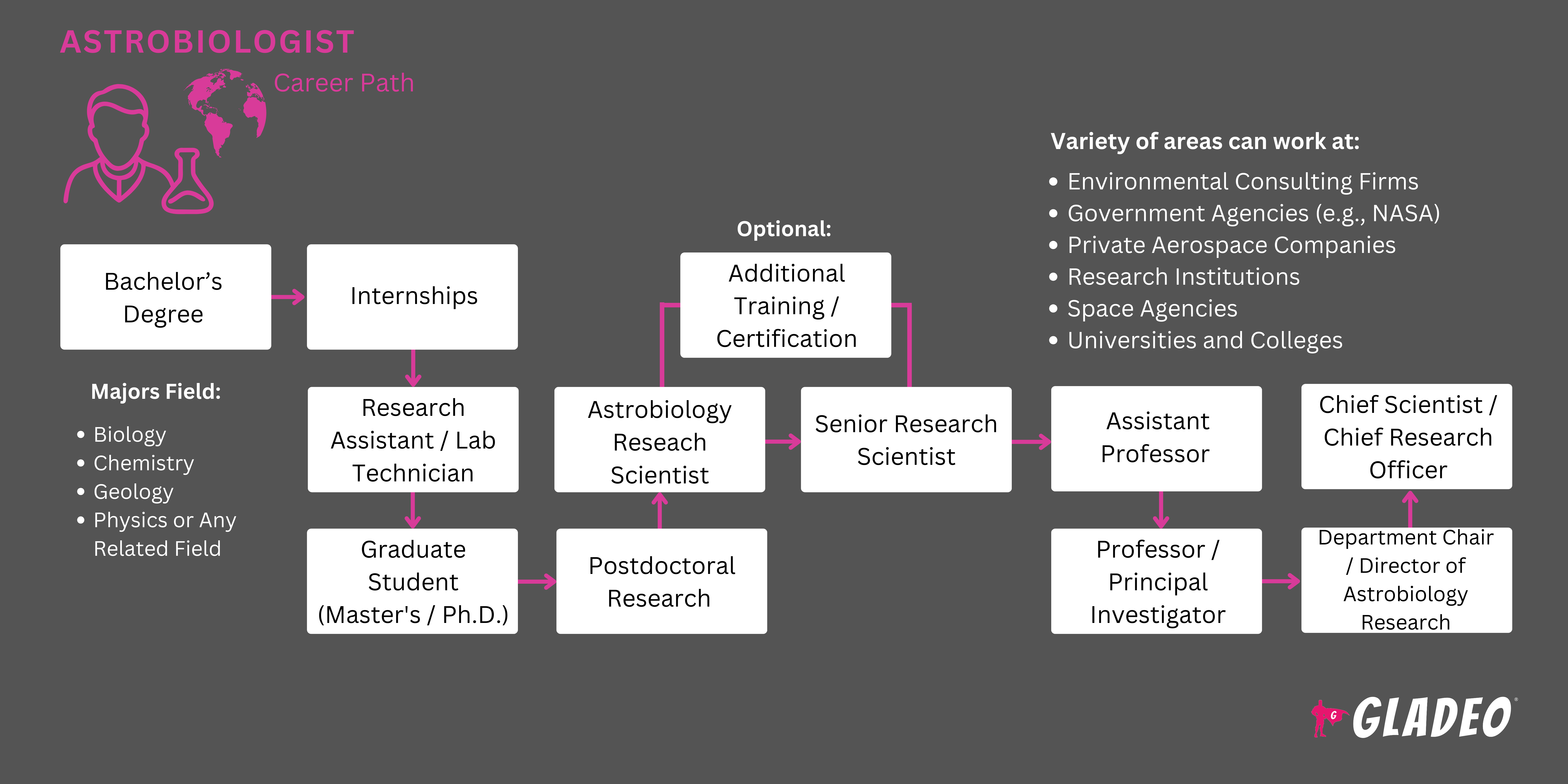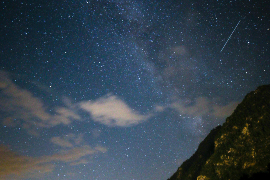Mga spotlight
Planetary Scientist, Astrophysicist, Exoplanet Researcher, Space Mission Scientist, Astrobiochemistry Researcher, Molecular Biologist, Space Instrumentation Scientist, Robotic Systems Engineer
Is there life on other planets? That question has been pondered for thousands of years!
Ancient Greek philosophers like Epicurus imagined that our universe contained countless other worlds – and that some were likely inhabited. During the Renaissance, astronomers like Giordano Bruno proposed that stars were suns with their own planets that potentially supported life.
As science and technology advanced, we stopped simply speculating and started actually searching for extraterrestrial life. On the forefront of this epic quest are Astrobiologists, aka exobiologists, who explore the origins, evolution, distribution, and future of life in the universe. They study extreme environments where life manages to thrive and analyze data from space telescopes to detect possible biosignatures on other planets, as part of their ongoing mission to investigate the potential for life beyond Earth,
As a unique interdisciplinary field combining aspects of biology, chemistry, geology, and astronomy, astrobiology aims to address once and for all one of the most profound questions humanity has ever struggled with: Are we alone in the universe?
- Contributing to the understanding of life’s potential beyond Earth
- Engaging in cutting-edge research and space exploration missions
- Collaborating with a diverse scientific community
- Advancing knowledge in multiple scientific disciplines
Oras ng trabaho
Astrobiologists typically work full-time, with schedules varying based on research demands. Their work environments include laboratories, observatories, and field sites with extreme conditions analogous to other planets.
Mga Karaniwang Tungkulin
- Conduct research on extremophiles (organisms that thrive in extreme environments) and methanotrophs (organisms that thrive around normally toxic metals like arsenic, cadmium, copper, lead and zinc) to understand potential extraterrestrial life conditions.
- Extremophiles include thermophiles (able to live in extreme heat), cryophiles (able to live in extreme cold), anaerobes (able to live without oxygen), and halophiles (able to live in salty environments).
- Study chemical and physical processes on moons, meteorites, and planets (besides Earth) that could support the habitability of life.
- Use spectroscopy and remote sensing to identify potential biosignatures in exoplanet atmospheres. Investigate any discovery of chemical signatures of life.
- Design and conduct lab experiments to simulate extraterrestrial environments and test theories about prebiotic chemistry and the origins of life.
- Examine microbial survival in simulated Mars and deep-space environments.
- Develop and test instruments for space missions. Work with robotic spacecraft, rovers, and probes to collect and analyze extraterrestrial samples.
- Analyze data collected from telescopes.
- Develop models predicting where life might exist in the universe.
- Assist with space mission planning related to life detection, and the development of planetary protection protocols.
- Develop AI and machine learning models to analyze large amounts of astrobiological data.
- Contribute to the design of life-support systems for human space travel.
Karagdagang Tungkulin
- Publish research findings and present at scientific conferences. Peer review article submissions.
- Communicate findings to the public through educational outreach.
- Apply for research grants and funding.
- Consult governmental and private space agencies. Participate in international collaborations.
- Develop protocols for handling extraterrestrial materials.
- Assist in establishing databases for cataloging experiment results.
- Study the effects of space environments on biological organisms for astrobiological insights
- Provide technical support to researchers, as needed.
- Review scientific literature to keep up with advancements.
- Train new team members and wear appropriate personal protective equipment.
Soft Skills
- Analitikal na pag-iisip
- Pansin sa detalye
- Komunikasyon
- Pagkausyoso
- Focus
- Integridad
- Mga kasanayan sa organisasyon
- pasensya
- Pagtugon sa suliranin
- Pagtutulungan ng magkakasama
- Pamamahala ng oras
Teknikal na kasanayan
Astrobiologists need hard skills related to the following:
- Laboratory techniques and procedures (e.g., sterilization, sample preparation, culturing extremophiles)
- Data analysis and statistical software (Excel, R, MATLAB, Python, laboratory management software)
- Field sample and specimen collection using instruments such as spectrophotometers, mass spectrometers, electron microscopes, and PCR machines
- Scientific instruments and laboratory equipment (e.g., gas chromatography, DNA sequencers, and fluorescence microscopy)
- Health, biological, and chemical safety protocols (e.g., biosafety levels and handling of hazardous materials)
- Microscope operation and imaging techniques (e.g., electron and confocal microscopy)
- Technical writing/documentation for research publications, grant proposals, and mission reports
- Biological sample preparation and handling, including cryopreservation and microbial isolation
- Data entry and database management, using bioinformatics and geospatial mapping tools
- Animal caretaking for research involving extremophiles or spaceflight biological studies (if applicable)
- Spectroscopy and remote sensing for analyzing planetary atmospheres and surface compositions
- Genomics and molecular biology techniques, such as CRISPR gene editing, DNA/RNA sequencing, and protein analysis
- Machine learning and AI applications
- Planetary simulation and environmental modeling, including computational models for extraterrestrial habitability
- 3D modeling and visualization software (e.g., ArcGIS, MATLAB Simulink)
- Field research equipment for studying analog environments (e.g., deep-sea hydrothermal vents, deserts, or polar ice caps)
- Astrochemistry techniques (e.g., analysis of organic molecules in meteorites and interstellar dust)
- Robotic systems operation (e.g., programming and managing rovers, drones, or autonomous sampling devices)
- Government agencies (e.g., NASA)
- Mga institusyon ng pananaliksik
- Universities and colleges
- Private aerospace companies
- Mga kumpanya sa pagkonsulta sa kapaligiran
Astrobiologists are expected to conduct meticulous, detail-oriented research, often requiring long hours in laboratories, field sites, or areas where spacecraft and instruments are prepared for space missions.
Unlike many scientific disciplines, astrobiology doesn’t focus on one field; it is inherently interdisciplinary, requiring knowledge of biology, chemistry, geology, and astronomy. That means Astrobiologists have got to work cohesively with experts from different scientific backgrounds, and commit to lifelong learning to stay up-to-date on research and methods.
Fieldwork can be exciting, with trips to extreme environments to study life forms that can survive there. These analog environments help them imagine what other types of worlds life could live on. The downside is, such places are often isolated, very hot or cold, and potentially dangerous. Also, some expeditions demand weeks or even months away from home, which can be hard on family and friends.
Securing funding is also a challenge. Many Astrobiologists rely on critical research grants from NASA, the European Space Agency, the National Science Foundation, and other organizations. Without those funds, they may not be able to continue their work. But the competition to get the grants is fierce, and funding can be influenced by governmental changes in budgetary priorities.
Astrobiology is a rapidly advancing field, due to new technologies and discoveries. Space-based telescopes like NASA’s Kepler and TESS have enabled the detection of thousands of exoplanets, some of which could support life. Kepler, which operated from 2009 to 2018, searched the stars from a heliocentric orbit while TESS, launched in 2018, follows an elliptical orbit around Earth on its mission to identify exoplanet candidates.
Any promising planets found by these missions are reported to the team in charge of the James Webb Space Telescope. This powerful sun-orbiting telescope can then focus its infrared spectroscopy to study their atmospheres, looking for gases like water vapor, methane, and carbon dioxide. Together, these telescopes form a powerful system: Kepler and TESS find the planets, and JWST reveals what they’re made of!
Robotic missions are also crucial. The Mars Perseverance Rover is collecting samples for analysis while missions like Europa Clipper and Dragonfly aim to explore subsurface oceans on icy moons. These projects involve collaboration between governmental agencies like NASA and ESA and private companies such as SpaceX.
Artificial intelligence, of course, is also altering the astrobiology field, by processing vast amounts of planetary data and predicting where life might exist by simulating extraterrestrial environments. Meanwhile, public interest in astrobiology is growing thanks to educational initiatives and citizen science participation!
Individuals drawn to astrobiology often had a passion for stargazing, science fiction, and exploring nature. They probably did well in biology, chemistry, physics, and math classes, and participated in science fairs or astronomy clubs.
- Aspiring Astrobiologists need at least a bachelor’s in a scientific discipline like astrobiology, biology, chemistry, physics, or geology.
- Note, some universities offer dedicated astrobiology programs while others feature interdisciplinary tracks combining biology, planetary science, and chemistry.
- NASA maintains a helpful list of astrobiology courses and programs!
- A graduate degree in astrobiology is typically needed for research jobs. Postdoctoral fellowships (such as those at NASA’s Astrobiology Institute, the European Space Agency, or major universities) are also important for advanced or specialized training.
- Ang mga karaniwang kurso sa kolehiyo ay kinabibilangan ng:
- Astronomy
- Biology
- Chemistry
- Geology
- Mathematics
- Microbiology
- Physics
- Planetary Science
- Mga istatistika
- Hands-on experience in extreme environments (such as deserts, deep-sea hydrothermal vents, or polar regions) is valuable for studying life in extreme conditions.
- Astrobiologists need to be familiar with a range of scientific instruments, data analysis software, and laboratory techniques, via courses or on-the-job training. That’s why internships, laboratory research, and field studies are crucial for building practical experience.
- Relevant data analysis software includes Python (for data processing and machine learning), MATLAB (for numerical simulations), and R (for statistical analysis).
- They also need to understand safety protocols for handling hazardous materials and biological specimens.
- Optional training opportunities include:
- NASA Science Mission Design School’s Planetary Science Summer School
- SETI Forward
- The SETI Research Institute’s Research Experience for Undergraduates program
- NASA Research Coordination Network workshops
- National Registry of Environmental Professionals - Certified Environmental Scientist
- Remote sensing and Geographic Information Systems certifications
- Scuba diving certification (for fieldwork in extreme underwater analog sites)
- Hazardous Materials (HAZMAT) training (for working with biological or chemical specimens in lab settings)
- Since astrobiology is interdisciplinary, professionals may pursue certifications in areas like AI, machine learning, bioinformatics, spectroscopy, planetary geology, or data science.
- Accredited programs in astrobiology, biology, chemistry, physics, planetary science, or related fields. See NASA’s list of astrobiology courses and programs.
- Research opportunities in astrobiology, space science, or microbiology.
- Access to modern laboratories and computational tools.
- Internships or co-op programs with space agencies like NASA or ESA.
- Experienced faculty with expertise in space-related biological studies.
- Scholarships, financial aid, and research funding opportunities.
- Competitive tuition and fees, including in-state vs. out-of-state costs.
- Strong graduation and job placement rates.
Perhaps the best place to start your search is NASA’s own list of astrobiology courses and programs!
- In high school, take advanced courses in biology, chemistry, physics, and math to prepare for college-level training programs.
- Participate in science fairs, astronomy clubs, or robotics competitions.
- Develop analytical skills through data projects or related coursework.
- Join research projects, open-source collaborations, or internships related to space science or microbiology to gain experience.
- Develop technical skills in programming, bioinformatics, or remote sensing, which are valuable for astrobiology research.
- For example, you could learn coding and data analysis tools such as Python, MATLAB, or R!
- Follow NASA, the SETI Institute, and private company space missions and research papers on astrobiology topics. Private companies include:
- SpaceX - develops technologies for interplanetary travel, including sustaining life on Mars.
- Blue Origin - works on commercial spaceflight and supports research on space habitats.
- Lockheed Martin - collaborates with NASA on missions like OSIRIS-REx, which studies organic materials from asteroids.
- Boeing - contributes to deep space exploration through projects like the Space Launch System.
- Northrop Grumman - supports astrobiology research through its work on the James Webb Space Telescope.
- Sierra Space - develops space habitats such as the Dream Chaser.
- Axiom Space - is advancing commercial space station technology that could enable long-term astrobiological studies.
- Nanoracks - specializes in microgravity research platforms, allowing biological experiments on the International Space Station.
- Relativity Space - is working on 3D-printed rockets that could support future planetary exploration.
- Rocket Lab - provides small satellite launches, enabling planetary science missions that could include astrobiology-related studies.
- Attend space science conferences and engage with professionals in the field.
- Seek mentorship from scientists working in space-related careers.
- Ask to do an informal interview with a working Astrobiologist!
- Keep track of work and academic accomplishments for your resume and/or college applications.
- Create a professional portfolio showcasing research projects, publications, and technical skills.

- Scan job portals like Indeed.com, Glassdoor, ZipRecruiter, and other sites. Also check the websites of any employer who might want to work for, in case they don’t advertise on job portals!
- Search for any job openings, internships, postdoctoral positions, or other opportunities with space agencies, private space-related companies, universities, and research institutions.
- Pay attention to the keywords in the job ads, and incorporate them into your resume, as applicable. For example:
- Astrobiology
- Biosignatures
- Pagsusuri sa datos
- Exobiology
- Extremophiles
- Habitability
- Microbial life
- Organikong kimika
- Planetary science
- Space biology
- Space mission research
- Spectroscopy
- Customize your resume and cover letter for each application, clearly linking your skills to the job description.
- Network with people who work for organizations like the NASA Astrobiology Institute and the SETI Institute. Ask them to let you know about upcoming job opportunities.
- Hilingin sa mga dating propesor at superbisor na magsulat ng mga liham ng rekomendasyon o humiling ng kanilang pahintulot na ilista ang mga ito bilang mga sanggunian.
- Make a profile on LinkedIn and other networking platforms to advertise your availability.
- Prepare for interviews by reviewing the employer’s mission and values. Brush up on your terminology and recent discoveries in astrobiology and space exploration.
- For example, follow professional organizations and conferences such as the Astrobiology Science Conference or the European Astrobiology Network Association.
- Be ready to demonstrate proficiency in laboratory techniques, field research, and data analysis.
- Check out Astrobiologist resume templates for ideas.
- Read sample interview questions such as “How do you approach the study of biosignatures in extreme environments, and what methodologies do you find most effective?” or “Can you describe a past research project where you investigated potential habitability on another planet or moon? What were your key findings and challenges?”
- Sanayin ang iyong mga tugon sa pamamagitan ng mga kunwaring panayam .
- Magsuot ng angkop para sa mga panayam sa trabaho !
- Talk with your supervisor about career advancement. As needed, pursue a higher level degree, or additional training in planetary science, bioinformatics, geochemistry, or remote sensing. For example:
- American Geophysical Union - Advanced Planetary Science Certification
- International Association of Geoanalysts - Certification in Geochemical Analysis
- International Society for Computational Biology - Advanced Bioinformatics Certification
- International Society for Photogrammetry and Remote Sensing - Professional Certification in Remote Sensing Applications
- MIT Professional Education - Advanced Certification in Computational Science and Data Analysis
- NASA Astrobiology Institute - Astrobiology Research Training Certification
- NASA Science Mission Directorate - Exoplanet Habitability and Biosignatures Certification
- Remote Sensing and Photogrammetry Society - Advanced Remote Sensing Certification
- Keep up with advancements in exoplanet research, habitability models, and space exploration technologies.
- Volunteer for planetary field research/analog missions in extreme environments.
- Become an expert on cutting-edge technologies, such as AI-driven data analysis, spectroscopy, and biosignature detection methods.
- Learn to use advanced lab equipment, computational modeling tools, and planetary simulations.
- Take on specialized research areas such as microbial life in extreme environments, astrochemistry, or planetary habitability assessments.
- Collaborate with international researchers on astrobiology-focused space missions and laboratory experiments.
- Join professional organizations like the NASA Astrobiology
Institute, the SETI Institute, or the American Society for Microbiology. - Publish research findings in peer-reviewed journals and present at major conferences like AbSciCon.
- Participate in workshops, webinars, and industry events to stay informed and expand your professional network.
- Build relationships with senior scientists and seek mentorship.
But also get leadership experience by mentoring students, leading lab teams, or assisting in academic programs. - Seek positions with increasing responsibility, such as principal investigator roles, mission scientist positions, or leadership in space agency research teams.
- Apply for research grants to fund independent projects and expand your contributions.
- Consider relocating or seeking positions with space agencies, universities, or private space companies that focus on astrobiology research.
Mga website:
- Astrobiology Journal
- Astrobiology Web
- Axiom Space
- Blue Marble Space Institute of Science
- Blue Origin
- Boeing
- Discover Life
- Dragonfly
- Earth and Planetary Science Letters
- Europa Clipper
- European Astrobiology Network Association
- European Space Agency - Astrobiology Research
- Exoplanet Exploration Program
- Habitability and Biosignatures Database
- Icarus (Planetary Science Journal)
- International Astronomical Union - Astrobiology Commission
- International Journal of Astrobiology
- International Space Station
- James Webb Space Telescope
- Life (MDPI Journal)
- Lockheed Martin
- Mars Perseverance Rover
- NASA: Kepler vs TESS
- NASA Astrobiology Institute
- NASA Exoplanet Archive
- NASA Planetary Science Division
- Northrop Grumman
- Planetary and Space Science
- SETI Institute
- Sierra Space
- SpaceX
- The International Society for the Study of the Origin of Life
- The ISME Journal (Microbial Ecology)
Mga libro
- Astrobiology: Understanding Life in the Universe, by Charles S. Cockell
- The Search for Life on Mars, by Elizabeth Howell and Nicholas Booth
- The Secret Life of the Universe: An Astrobiologist’s Search for the Origins and Frontiers of Life, by Nathalie A. Cabrol
Astrobiologists are important front-line members of the space research community, but there are plenty of other professions to consider if this career isn’t resonating with you. Check out our list below for some ideas!
- Aerospace Engineer
- Agricultural Scientist
- Astronaut
- Astronomer
- Biochemist
- Espesyalista sa Bioinformatics
- Biological Scientist
- Biomedical Engineer
- Bioprocessing Technician
- botanista
- Teknikong kimikal
- Conservation Scientist
- Cytogenetic Technologist
- Data Scientist
- Ecologist
- Siyentipiko sa Kapaligiran
- Food Safety Specialist
- Forensic Science Technician
- Geneticist
- Geophysicist
- Histotechnologist
- Marine Biologist
- Medical Laboratory Technician
- Microbiologist
- Molecular Biologist
- Nanotechnology Engineering Technologist
- Oceanographer
- Pharmacologist
- Planetary Scientist
- Plant Science Technician
- Toxicologist
- Veterinary Technician
- Wildlife Biologist
- Zoologist
Mag-click dito upang i-download ang infographic
Newsfeed

Mga Tampok na Trabaho

Mga Online na Kurso at Tool







